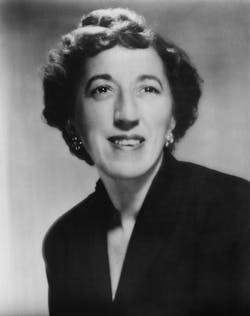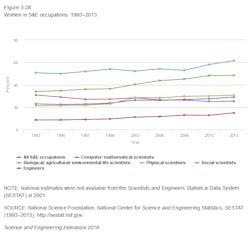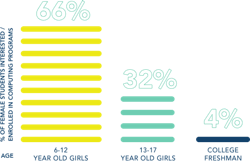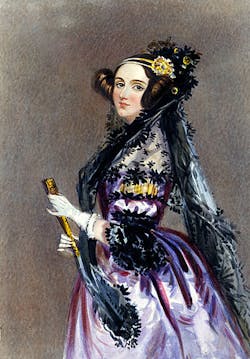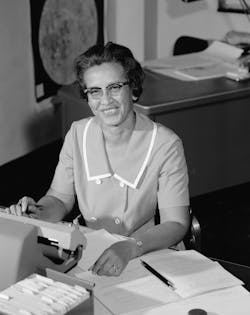Lovelace is remembered for writing an algorithm at age 17 that was employed on Charles Babbage’s Analytical Engine. The engine was programmed mechanically to generate numbers in the Bernoulli Series. For this accomplishment, she has been named one of the pioneers of modern-day computer science.
Lovelace's interest in math and science started at an early age. Unlike the majority of English women in the Victorian Era, she was encouraged to study mathematics and science, and was permitted the resources to do so. Support from her mother allowed her to develop a passion for problem solving that she employed throughout her lifetime.
Today, studies from the National Science Foundation (NSF) show that women, blacks, Hispanics, and American Indians/Alaska Natives are underrepresented in science and engineering (S&E) fields. An NSF 2016 report shows that only 29% of jobs in S&E were held by women in 2013, with 15% holding engineering jobs, and 25% holding computer and mathematical sciences jobs (below).
Furthermore, after the computer-science workforce nearly doubled in the early 1990s, bringing in significantly more women participants, the number of women in computer science fields has been on the decline ever since. A whitepaper from Techbridge cites an NSF paper from 2015 that shows minority women only earn 3% of engineering bachelors degrees, 5% of computer-science bachelor degrees, and 6% of physics bachelor degrees. The NSF describes the disparity of minorities and women in STEM work as "an underutilized source of human capital."
To address this disparity, there are a wide range of initiatives that encourage diversity in STEM. Engaging students from various backgrounds and building support systems requires effort from communities and professionals to volunteer, seek funding, and mentor. Knowledgeable individuals are needed to work at summer and after-school programs to teach math, logic, and problem-solving skills to youth so that they can build confidence and face difficult challenges.
Clubs, societies, and meet-up groups also are vital resources for young professionals to help build relationships within their communities. Community based opportunities help reach underrepresented youth and provide a means for them to express interest in STEM professions.
Google provides another example of diversity outreach. It tackles diversity issues in Silicon Valley with its Code Next program in Oakland, California, to help black and Latino students gain skills to earn jobs at close technology hubs like Silicon Valley. Code Next teaches coding, game development, 3D modeling, and other computer-based skills. Google plans on opening another location for Code Next in Harlem in 2017.
Girls Who Code (GWC), a program based in New York, NY, provides another example. One of its missions is to preserve the interest of young girls in STEM as they enter adulthood. GWC offers after-school club programs to girls in grades 6-12, and also offers Summer Immersion Programs to 10th and 11th graders. The summer programs are held at leading technology companies like AT&T, Autodesk, and Microsoft. The programs are free, and GWC also offers stipends to cover living expenses and transportation for those who qualify for aid. The organization reaches 10,000 girls across the country. In 2015, 34 companies in 11 U.S cities hosted 57 Summer Immersion programs. The application for GWC summper programs is currently closed; interested parties are encouraged to sign up for the mailing list to get a head start on joining next year.
Women in STEM and LGBT+
The Society of Women Engineers (SWE) supports women pursuing ABET-accredited bachelors and graduate degrees by offering scholarships, awards, hosting the WE16 summit, and job listings which creates a sense of community. This year, they have awarded more than $750,000 to 231 new and renewed scholars. SWE also reaches out to female youth through SWENext, providing opportunities to meet female engineers and earn scholarships. Their All Together Blog discusses opportunities for women to support one another. Their mentoring program relies on professional women to volunteer as mentors for college students.
The Girl Scouts is also increasing their focus on STEM. It urges troop leaders to investigate the new STEM curriculum so they can learn how to encourage young girls interested in STEM. Other programs include Imagine STEM Series and a curriculum called Helping Girls become STEM Superstars. The Girl Scouts suggests that troop leaders offer trips to science museums and universities, and seek speakers that can help kids perceive STEM as a viable career path for all women. The organization also teams with Google to offer Made with Code, which allows troops to compete and learn how to program.
Lesbians Who Tech offers scholarships and community-building events for queer women in computer science, including an annual New York Summit. Members can also apply for the Edie Windsor Coding Scholarship, named after Edith “Edie” Windsor, an LGBQT rights activist and former technology manager at IBM. The scholarship funds coding tuition by 50%.
Racial and Ethnic Minorities
The National Society of Black Engineers, and the Society of Hispanic Professional Engineers reach out to blacks and Latinos, and provide mentoring programs for kids K-12. The National Action Council for minorities in engineering offers scholarships and corporate support, and People of Color in Tech offers networking events, a career center, mentoring, and education opportunities.
Another program in Oakland is Hack the Hood (HtH), which is a 6-week boot camp that teaches writing basic HTML and CSS, web design, leadership and soft skills, and builds professional skills to black and Latino youth. Peoples ages 16-20 can apply in the summer, and ages 18-25 can apply in the Spring. Oakland also offers Black Girls Code, and Black Boys Code is coming soon. The application for HtH is currently closed; interested parties are encouraged to sign up for the mailing list to get a head start on joining next year.
Ada Lovelace was encouraged from an early age to study math and science to prevent her from becoming like her father, the romantic poet, George Byron. At the age of 17 (year 1832), Lovelace met Charles Babbage, who showed her his plans for creating an Analytical Engine. Impressed by her interests in mathematics and advanced language skills, he asked her to translate a French transcription of one of his lectures. Lovelace got “a little carried away”, adding pages upon pages of notes and ideas to his paper and subsequently writing an algorithm that could be used with the machine to generate numbers in the Bernoulli series. Babbage published these notes along with his paper describing his Analytical Engine, but it wasn’t until more than a century after her death that Lovelace’s notes were recognized as computer software for what would be the world’s first computer.
Katherine Johnson joined the Guidance and Navigation department for the National Advisory Committee for Aeronautics (NACA, which later became NASA) in 1953. She worked as a "computer", continuously performing calculations from data incoming from the black boxes of airplanes. She moved on to become an aerospace technologist and an integral part of the Spacecraft Controls Branch, where she calculated the trajectories of spacecraft and return-flights paths. She was awarded the Presidential Metal of Freedom in 2015 for her contributions to African Americans in STEM. A movie about her accomplishments called Hidden Figures will be released in 2017.

